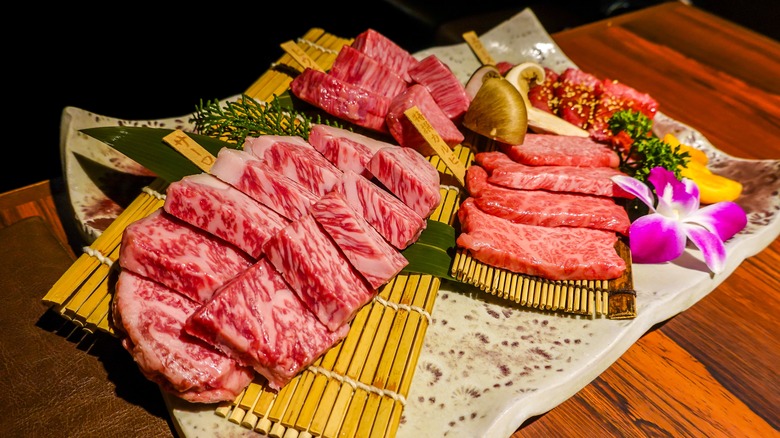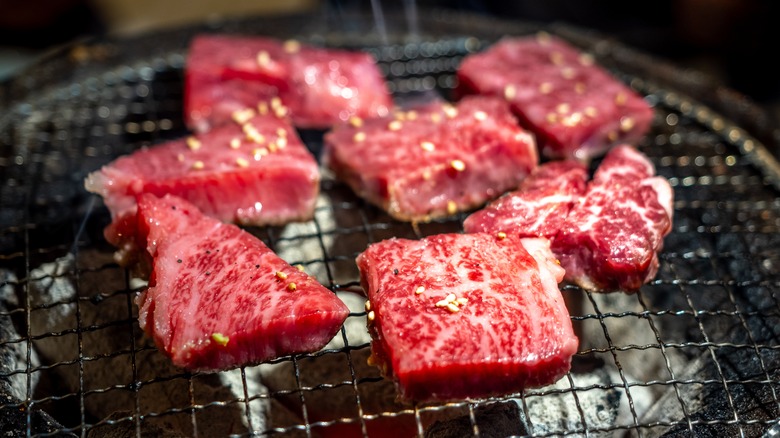Why Is Wagyu Beef So Expensive And Is It Worth The Price Tag?
Wagyu beef is widely regarded as the pinnacle of Japanese culinary excellence, celebrated for its keen eye on quality and expert craftsmanship. This marbled beauty is among the most expensive meats in the world, fetching a high price tag. In 2002, a Matsusaka wagyu cow sold for an eye-watering $400,000 — so it's truly in a superior category of its own, blending tradition with culinary artistry. To delve deeper into why wagyu beef is so expensive, and to see if it's truly worth the price, Food Republic consulted Golan Haiem — founder and CEO of Destination Wagyu — who explained that "the price of wagyu comes down to genetics, time, and precision."
Compared to standard beef cattle, wagyu beef undergoes specialized rearing. While most regular beef cattle are slaughtered between 15 to 24 months of age, wagyu cattle "are raised much longer ... often close to three years," Haiem explained. "Their diet is highly controlled, often grain-finished for over 400 days." The long rearing time and high-energy, fattening diet — rich in grains and rice straw — lead to high levels of intramuscular fat (also known as marbling), which "gives wagyu its rich, buttery texture and clean finish," Haiem added. This rearing process is far from cheap or time-effective. Wagyu cattle are raised in a low-stress environment with high-quality treatment (even receiving massages, according to popular lore) that requires a significant investment of time, care, and resources to produce superior-quality meat.
So, is wagyu worth the indulgence? "If you're looking for something unique and high quality, yes," Haiem says. "It justifies the price."
Wagyu isn't cheap to import
Another reason for wagyu's high price is that "importing real Japanese wagyu adds even more cost because of limited supply, certifications, and shipping requirements," Golan Haiem told us. Japan imposes stringent certifications that trace lineage, breeding, and raising practices. Calves are provided with a unique identification code that tracks their lineage back three generations. Japan also has strict criteria on what cattle can be used for wagyu, designating only four breeds: Japanese Black (which accounts for over 90% of wagyu), Japanese Brown, Japanese Shorthorn, and Japanese Polled.
Wagyu is also meticulously categorised using a strict grading system based on two factors: yield and quality. The yield grade indicates the proportion of usable meat, ranging from A (highest) to C (lowest). The quality grade assesses marbling, color, texture, and fat quality, with 5 being the best and 1 the lowest. This means that A5 wagyu represents the highest possible tier — superior in both yield and quality, and therefore boasting the highest price tag — while C1 is the lowest. However, lower grades can still offer excellent flavor and texture at a more accessible price, appealing to diners who want to taste wagyu without the steep markup of A5. The price difference between grades reflects that the high price point of wagyu is entirely due to its impeccable quality, meaning the more you pay, the more refined and intensely flavorful your wagyu experience will be.
How to prepare wagyu for the best taste
According to Golan Haiem, "Wagyu is an experience. It's not about size or volume. Expect small portions, intense flavor, and a texture that melts in your mouth." Wagyu isn't traditionally eaten in large quantities; instead, it's meant to be appreciated for its delicate quality. Typically, it's enjoyed via techniques such as yakiniku (thinly sliced and quickly grilled) or shabu-shabu (hot pot style), which lightly renders out the fat, basting the meat and enhancing its flavor. It's not recommended to order wagyu well-done, as the fat may completely render out, causing it to become dry and tough (which is why overcooking the meat is one of the biggest mistakes people make when preparing wagyu at home).
If you want to cook the beef yourself, Haiem recommends: "You don't need to do much to it. Just a good sear ... cast iron or a flat top works great." A three or four minute sear on each side of a one-inch-thick wagyu cut is recommended. Because of wagyu's rich marbling, it cooks much faster than regular beef — and remember, the higher the grade, the faster it cooks. Minimal seasoning is required; a little salt can be added to enhance the flavor (and wagyu also pairs well with white wine). It's recommended that you don't mask the rich, natural flavors with bold seasonings or heavy sauces. Ultimately, the richness, refinement, and need for careful preparation justify the price. As Haiem puts it, when you're splurging on wagyu, "you're tasting beef at its most refined."



